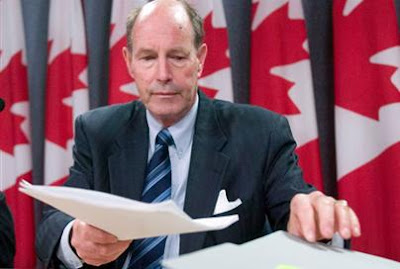Can We Dodge the Fiscal Bullet?

My boss emailed me this afternoon telling me the former governor of the Bank of Canada, David Dodge, was in Montreal. He asked me whether I would like to go listen to his speech and I immediately jumped at the opportunity.
David Dodge is one of the smartest people in finance and listening to him speak was a real treat. If I were running a big global macro hedge fund, I'd hire him as a senior advisor. His knowledge of economics and global economic issues is deep and comprehensive.
Mr. Dodge was the guest speaker at CIRANO. His presentation was entitled "Emerging from the Crisis: the Fiscal and Monetary Policy Challenges Ahead".
He began by going over the origins of the crisis, paying close attention to global imbalances, financial market innovation and underpricing of risk.
He then discussed how central banks and governments dealt with the crisis through liquidity provisions and government bailouts. He emphasized that automatic fiscal stabilizers accounted for over 50% of the fiscal deficits and that it wrong to think that the bailouts were the only driving force behind mushrooming fiscal deficits.
Mr. Dodge then listed four factors driving the economic rebound (he did not call it a recovery but a rebound):
1) reversal of inventory cycle
2) huge fiscal stimulus
3) extraordinary low interest rates
4) house price stabilization
And he listed two factors driving the financial rebound:
1) pessimism of last winter was overshot
2) extraordinary liquidity provision by central banks
According to Mr. Dodge, the rebound has come one or two quarters earlier than predicted last winter because of the size and speed of coordinated monetary and fiscal policy. The global economic contraction in 2009 now seems likely to be only 1% 9versus 2% last winter). Growth in 2010 now likely to be 3% (versus 2% last winter). Inflation is well contained.
But Mr. Dodge warned that private demand is still weak, household balance sheets in OECD remain problematic, and unemployment still to peak in 2010.
As far as the global financial system, Mr. Dodge said catastrophe was averted in 2009 but a substantial "hangover" remains:
- government ownership of financial institutions
- huge government deficits and high debt
- central banks expanded balance sheets
- securitization very weak and bank credit tight
- And rebuilding of the system still to come
In particular, he noted the following key issues for market regulators:
- standardization of instruments
- building of continuous markets
- regulating credit default swaps
- need to develop a sustainable private mortgage market
- need to harmonize accounting standards
- In 2007, Canadian federal and provincial bugets show a small surplus (1.3% of GDP)
- Big reduction in net debt to to about 52% of GDP
- Favorable terms of trade led to stronger nominal income growth (2002-2007)
In his fiscal outlook, Mr. Dodge went over several factors affecting future spending:
- Assume temporary programs expire more or less as scheduled in 2011/12
- Spending programs then largely driven by changing demographics
- Health care costs continue to increase driven by aging (6%+)
- Elderly benefit costs set to increase
Restraint of this magnitude is very difficult and disruptive so some tax increases will be necessary.
To cut spending by 1 1/2% (1/2% of GDP per year), Mr. Dodge said you need to:
- hold real capita spending to 1% growth p.a.
- cut other real spending on other programs by 2% p.a.
- raise the harmonized sales tax (HST) by 2%
- some form of carbon tax
- raise user charges (eg. student fees)
- Hold interest rates at zero 'til mid 2010 but reduce non-conventional initiatives
- With credible fiscal plan, policy can remain accomodative through 2015, i.e. slow increase in policy rates to 2% (zero real) in 2010-2011 and hold below "neutral" through remainder of period to compensate for fiscal drag and continuing (small) output gap
- Canada is not an island
- USA must reduce net absorption and Asia (especially China) increase net absorption (he also mentioned that other EM can start to run current account deficits)
- Canada will have to adjust for global policy changes and unforeseen events
- Adjustments can best be accomplished if baseline fiscal plan is credibly set to achieve balance (less than 1% deficit) by 2015 and monetary policy set to keep inflation at 2%
Comments
Post a Comment